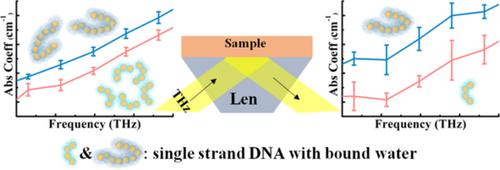当前位置:
X-MOL 学术
›
J. Biophotonics
›
论文详情
Our official English website, www.x-mol.net, welcomes your feedback! (Note: you will need to create a separate account there.)
Detection of gene mutation responsible for Huntington's disease by terahertz attenuated total reflection microfluidic spectroscopy
Journal of Biophotonics ( IF 2.8 ) Pub Date : 2020-09-27 , DOI: 10.1002/jbio.202000315 Mingjie Tang 1, 2 , Mingkun Zhang 1 , Liangping Xia 1, 3 , Dongshan Wei 1, 4 , Zhongbo Yang 1 , Shihan Yan 1 , Chunlei Du 1 , Hong-Liang Cui 1
Journal of Biophotonics ( IF 2.8 ) Pub Date : 2020-09-27 , DOI: 10.1002/jbio.202000315 Mingjie Tang 1, 2 , Mingkun Zhang 1 , Liangping Xia 1, 3 , Dongshan Wei 1, 4 , Zhongbo Yang 1 , Shihan Yan 1 , Chunlei Du 1 , Hong-Liang Cui 1
Affiliation

|
Terahertz absorption spectroscopy based on attenuated total reflection (ATR) from a microfluidic sample cell was designed and implemented to detect gene mutations leading to Huntington's disease (HD). The self‐developed compact ATR microfluidic system was employed to detect two groups of base‐repeated DNA molecules combined with a terahertz time‐domain spectrometer in a marker‐free manner. The first group featured different repetition patterns of oligonucleotide fragments, and the second group included the HD gene. For the oligonucleotides of different repetition patterns, there were significant differences among the three oligonucleotides with three repeats of the double bases, which could be unambiguously classified and identified; For the HD gene, it was found that the magnitude of the terahertz absorption coefficients of the four oligonucleotide solutions was, in ascending order, CAG‐4 < CAG‐16 < CAG‐32 < CAG‐40 (the numbers are the repeat times of the CAG base segment, with 40 repeats belonging to the HD gene), when the concentration of oligonucleotide was 1 mg/mL. Principal component analysis result indicated that the spectral differences of the four oligonucleotide solutions with different CAG repeat times were statistically significant and clearly distinguishable. These results demonstrate the potential of terahertz spectroscopy as a noninvasive, unmarked, fast and low‐cost assay for gene diagnosis and clinical disease detection.
中文翻译:

太赫兹衰减全反射微流控光谱法检测导致亨廷顿氏病的基因突变
设计并实现了基于微流样本细胞衰减全反射(ATR)的太赫兹吸收光谱,以检测导致亨廷顿病(HD)的基因突变。自行开发的紧凑型ATR微流控系统与太赫兹时域光谱仪结合使用,以无标记的方式检测了两组碱基重复的DNA分子。第一组具有不同的寡核苷酸片段重复模式,第二组包含HD基因。对于具有不同重复模式的寡核苷酸,在具有三个双碱基重复的三个寡核苷酸之间存在显着差异,可以明确分类和鉴定。对于高清基因,发现四种寡核苷酸溶液的太赫兹吸收系数的大小按升序排列为CAG‐4 <CAG‐16 <CAG‐32 <CAG‐40(数字是CAG基础片段的重复次数,当寡核苷酸的浓度为1 mg / mL时,有40个重复序列属于HD基因)。主成分分析结果表明,四种具有不同CAG重复时间的寡核苷酸溶液的光谱差异具有统计学意义,并且可以清晰地区分。这些结果证明了太赫兹光谱技术作为基因诊断和临床疾病检测的一种非侵入性,无标记,快速且低成本的测定方法的潜力。当寡核苷酸的浓度为1 mg / mL时,有40个重复序列属于HD基因)。主成分分析结果表明,四种具有不同CAG重复时间的寡核苷酸溶液的光谱差异具有统计学意义,并且可以清晰地区分。这些结果证明了太赫兹光谱技术作为基因诊断和临床疾病检测的一种非侵入性,无标记,快速且低成本的测定方法的潜力。当寡核苷酸的浓度为1 mg / mL时,有40个重复序列属于HD基因)。主成分分析结果表明,四种具有不同CAG重复时间的寡核苷酸溶液的光谱差异具有统计学意义,并且可以清晰地区分。这些结果证明了太赫兹光谱技术作为基因诊断和临床疾病检测的一种非侵入性,无标记,快速且低成本的测定方法的潜力。
更新日期:2020-09-27

中文翻译:

太赫兹衰减全反射微流控光谱法检测导致亨廷顿氏病的基因突变
设计并实现了基于微流样本细胞衰减全反射(ATR)的太赫兹吸收光谱,以检测导致亨廷顿病(HD)的基因突变。自行开发的紧凑型ATR微流控系统与太赫兹时域光谱仪结合使用,以无标记的方式检测了两组碱基重复的DNA分子。第一组具有不同的寡核苷酸片段重复模式,第二组包含HD基因。对于具有不同重复模式的寡核苷酸,在具有三个双碱基重复的三个寡核苷酸之间存在显着差异,可以明确分类和鉴定。对于高清基因,发现四种寡核苷酸溶液的太赫兹吸收系数的大小按升序排列为CAG‐4 <CAG‐16 <CAG‐32 <CAG‐40(数字是CAG基础片段的重复次数,当寡核苷酸的浓度为1 mg / mL时,有40个重复序列属于HD基因)。主成分分析结果表明,四种具有不同CAG重复时间的寡核苷酸溶液的光谱差异具有统计学意义,并且可以清晰地区分。这些结果证明了太赫兹光谱技术作为基因诊断和临床疾病检测的一种非侵入性,无标记,快速且低成本的测定方法的潜力。当寡核苷酸的浓度为1 mg / mL时,有40个重复序列属于HD基因)。主成分分析结果表明,四种具有不同CAG重复时间的寡核苷酸溶液的光谱差异具有统计学意义,并且可以清晰地区分。这些结果证明了太赫兹光谱技术作为基因诊断和临床疾病检测的一种非侵入性,无标记,快速且低成本的测定方法的潜力。当寡核苷酸的浓度为1 mg / mL时,有40个重复序列属于HD基因)。主成分分析结果表明,四种具有不同CAG重复时间的寡核苷酸溶液的光谱差异具有统计学意义,并且可以清晰地区分。这些结果证明了太赫兹光谱技术作为基因诊断和临床疾病检测的一种非侵入性,无标记,快速且低成本的测定方法的潜力。



























 京公网安备 11010802027423号
京公网安备 11010802027423号